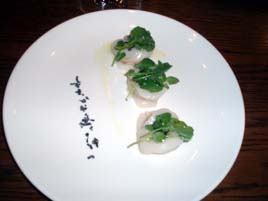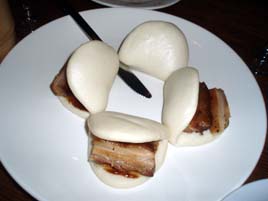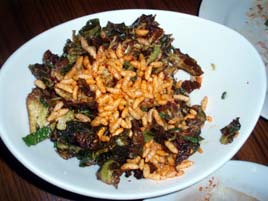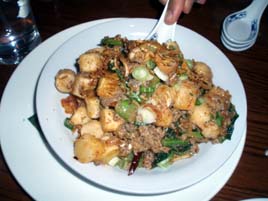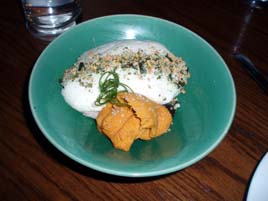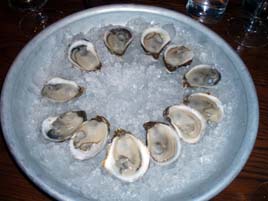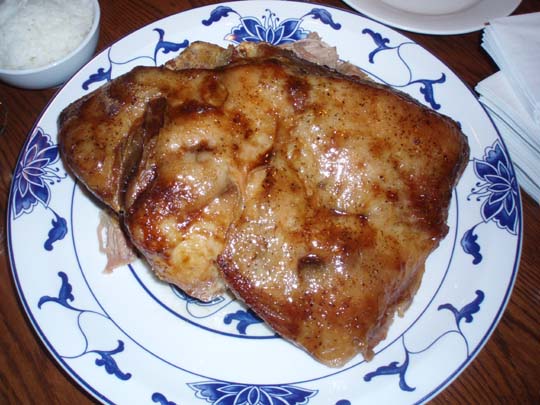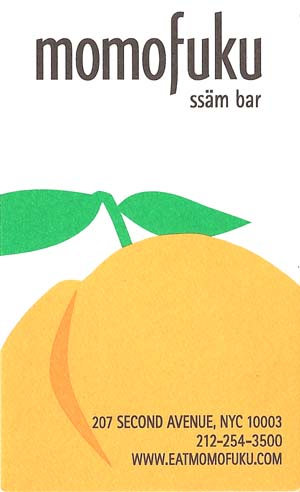
Note: Click here for a more recent visit to Momofuku Ssäm Bar.
On February 27, eGullet’s Steven A. Shaw (handle: “Fat Guy”) launched a discussion thread called, “Where to get the haute-cuisine experience, cheap.” The premise was Shaw’s observation that, these days, you don’t need to go to a “fine dining” restaurant to get haute cuisine.
Another eGullet member (handle: “Nathan”) dubbed this phenomenon the “New Paradigm” (“NP”), and it stuck—at least with Shaw, Nathan, and one other eGullet member who bought into the idea (handle: “Sneakeater”). Shaw would later claim that it was Bouley Upstairs that got him thinking along these lines, although the discussion thread was launched just six days after Frank Bruni’s two-star review of Momofuku Ssäm Bar.
What exactly is the New Paradigm? The very small band of people who believe in its existence chose a most peculiar lodestar — Frank Bruni himself — though Bruni has never acknowledged a “paradigm” in any review except the one that launched it:
[Momofuku Ssäm Bar] has emerged as much, much more than the precocious fast-food restaurant it initially was. By bringing sophisticated, inventive cooking and a few high-end grace notes to a setting that discourages even the slightest sense of ceremony, Ssam Bar answers the desires of a generation of savvy, adventurous diners with little appetite for starchy rituals and stratospheric prices.
They want great food, but they want it to feel more accessible, less effete. They’ll gladly take some style along with it, but not if the tax is too punishing. And that’s what they get at Ssam Bar, sleek, softly lighted and decidedly unfussy. Most of its roughly 55 seats are at a gleaming dark wood counter that runs the length of the narrow room, though these seats afford more elbow room than exists at the much smaller Noodle Bar.
Many of the remaining seats are at communal tables, and reservations aren’t taken…
There’s a good deal in Bruni’s description that’s patently offensive. Who’s to say that people who want to make a reservation and sit at a table are “effete”? Who’s to say that those who are “savvy” about fine food have “little appetite” for rituals that Bruni finds “starchy”? Bruni’s error, of course, is that he projects his own prejudice onto everyone else. He doesn’t like these things, so he just assumes nobody does—at least, nobody that knows what they’re talking about.
eGullet’s Nathan, who apparently counts mind-reading among his many skills, says that the purported phenomenon “especially appeals to a youthful but knowledgeable demographic.” We can readily believe that Nathan knows at sight who is youthful—although the clientele at Meatpacking District bars, and for that matter the McDonald’s across the street from Stuyvesant High School—seems pretty youthful too. How he discerns that the clientele are knowledgeable is beyond my comprehension. It’s Bruni’s error all over again: he counts himself as knowledgeable, and simply assumes that those dining where he does must be as smart as he is.
Shaw, perhaps realizing that restaurant critics shouldn’t be mind-readers, calls the alleged phenomenon, simply, “haute cheap.” Shaw mined an article (and a paycheck) out of his invention, with an article in the March 19 issue of Crain’s New York Business. He chose five restaurants to illustrate the concept: Momofuku Ssäm Bar, Bouley Upstairs, Degustation, Room4Dessert, and the Bar Room at the Modern.
I’ve dined at all five. Their points in common are not at all new, and can easily be attributed to other explanations. For many years, fine-dining restaurants have been offering casual dining at the bar to walk-in patrons. In a number of places, the “casual front room” takes on the identity of a separate restaurant, though clearly still affiliated with the “mother ship.” Bouley Upstairs and the Bar Room are two of the many examples of this. I love Room4Dessert, but it fails the first test: it may be haute, but it ain’t cheap—bearing in mind that it only serves dessert.
Degustation’s similarity to the others is only skin-deep. Patrons there sit at a bar (as they do at Ssäm Bar and Room4Dessert), and the menu there is “tapas-style” (hardly a novelty these days), but in most other respects it is fairly conventional. Even Shaw had his doubts about it: “Whether Degustation fits the pattern is an open question. I think the food, while quite good, is weaker and less haute than what’s available at Momo-Ssam, Upstairs and certainly the Bar Room at the Modern. Visiting Degustation between Momo-Ssam and Upstairs really emphasized that it’s operating at a lower level…”
Because the New Paradigm is such a tenuous concept, its three advocates have continually struggled to redefine it. Skeptics point out the many holes in their theory, and it morphs into something else. For instance, a no-reservations policy was allegedly a keynote of the paradigm, but three of Shaw’s five examples take reservations. Another canard was “no dress code whatsoever,” but in an age when only about 10 restaurants in town still have a dress code, that hardly narrows it down.

Menu
I paid another visit to Momofuku Ssäm Bar on a weeknight a couple of weeks ago (first visit here), to try to get my arms around this alleged paradigm. As I was by myself, I had no trouble getting a seat at around 7:00 p.m. (Couples who had arrived before me were still waiting, since there weren’t two adjacent bar stools available.) I actually had a pretty good seat, facing part of the open kitchen.
I decided to order two dishes at the opposite end of the Ssäm Bar spectrum: something funky, and something totally conventional. I started with the Veal Head Terrine ($13), mainly because I was alone, and my usual dining companions would have been totally grossed out. If you ignore where it came from, there’s nothing gross about the Veal Head Terrine (photo here). Its bark is worse than its bite.
The terrine is served warm, in a roughly 6”×8” portion sliced as thin as tissue paper. Frankly, I think that if it were sliced thicker, but with a smaller surface area, it would pack a heftier flavor punch. At first, I spread it on the toasted bread provided, but the terrine was overwhelmed. I ate the last half of it without the bread. It had a slightly spicy taste, but was not anything special.
Then I ordered the Milk-Fed Four Story Hill Farm Poulard ($26). For the curious, Frank Bruni had a blog post about this recently. It was a follow-up to his review of Resto. (The Gang of Three have not admitted Resto to the New Paradigm club, despite its similarity to the other restaurants mentioned.) Four Story Hill Farm is, of course, an impeccable poultry source, and Chang’s kitchen knew what to do with it. It was nearly as juicy and tender as you could want chicken to be, but nothing special was done with it. It was just chicken on a plate over a bed of warm leaf greens.
Actually, it struck me that if you ordered the chicken at Blue Hill, this is almost certainly what you’d get. I never had the chicken there, but I’ve dined at Blue Hill often enough to know the style. It would be the same quality of ingredients, and the same style of preparation. They do indeed offer a similar dish on their menu, and according to the website, it’s $30.
This anecdote helps to debunk the idea that Momofuku Ssäm Bar is “haute cheap.” For what is almost certainly the nearly-identical entrée, Blue Hill charges only $4 more. When you consider that dinner at Blue Hill has all of the traditional restaurant amenities, while Ssäm Bar has almost none of them, you could even argue that Ssäm Bar is over-priced. I can’t make any direct comparison of the Veal Head Terrine, because Blue Hill doesn’t serve anything like that. However, Blue Hill’s appetizers are in the $10-16 range, and the terrine was $13.
(I am prepared for the David Chang Army to advise that Chicken isn’t what Ssäm Bar is about. Too bad. They serve it; I ordered it. It was an experiment to see what Chang does with something conventional. It was pretty good chicken, but something I’m sure dozens of other restaurants are offering. Perhaps this section of the menu is meant to be “Ssäm Bar for Wimps,” but it wasn’t labeled that way.)
Before tax and tip, the total cost of my meal was $55, including two glasses of the house sake at $8 each. Obviously if you think Ssäm Bar is serving four-star food (which it isn’t), you could call it “cheap” in a sense. But objectively $55 isn’t a cheap meal, and of course Ssäm Bar isn’t serving four-star food anyway. It’s pretty close to what you’d pay for dinner at Blue Hill, but a whole lot less pleasant. It turns out that “haute cheap” isn’t really that cheap.
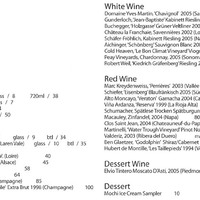
Beverage and Wine List
The wine list has improved since my last visit to Momofuku Ssäm Bar, and there seemed to more serving staff behind the counter. Both of my selections were delivered without silverware. Neither one could reasonably have been eaten with chopsticks (though those weren’t offered either). However, my requests for a knife and fork were quickly granted. The sound system played music at a noise level I found annoying.
You might have wondered whether the New York Times review affected business. The server I asked said it had. He said people come in “all the time” and mention the NYT review. As far as I could monitor, most of the orders coming out of the kitchen seemed to be pretty conventional stuff. I did see one additional order of the Veal Head Terrine. In that case, I happened to overhear the server steering a couple towards that choice. It appeared that only the guy could stomach it.
David Chang does some very good cooking, although you have to be willing to put up with a setting that is far from ideal, and verges to the unpleasant. In terms of comfort, it is probably the least appealing of the purported “New Paradigm” restaurants, and the quality of the food doesn’t quite overcome its many disadvantages.
Eating out, like most other things we do, has gotten progressively less formal since about the 1960s. There’s really nothing new about that, and it’s astonishing that a seasoned critic like Steven Shaw thinks so. One expects that from an arriviste like Frank Bruni, but not from Shaw. Momofuku Ssäm Bar, in its radical rejection of amenities we have come to expect in a restaurant, could be called a Paradigm of One. It really has no competitors. And frankly, I’m not aching for more of its kind. I’d rather pay the extra $4 for a table and a reservation.
Momofuku Ssäm Bar (207 Second Avenue at 13th Street, East Village)
Food: **
Service: *
Ambiance: Fair
Overall: *½
 Wednesday, December 10, 2008 at 02:16PM
Wednesday, December 10, 2008 at 02:16PM 



